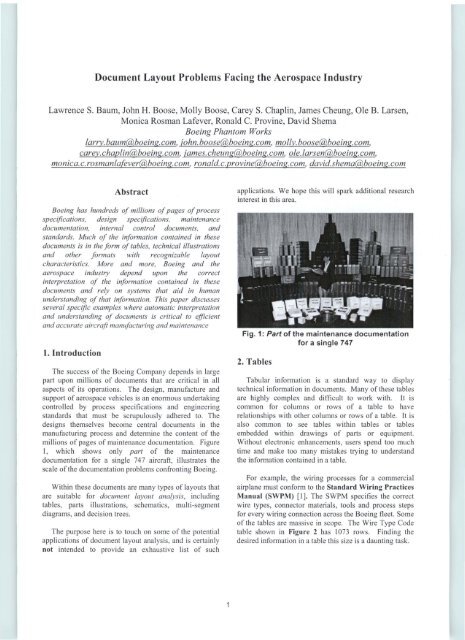RR_03_02
RR_03_02
RR_03_02
You also want an ePaper? Increase the reach of your titles
YUMPU automatically turns print PDFs into web optimized ePapers that Google loves.
Document Layout Problems Facing the Aerospace Industry<br />
Lawrence S. Baum, John H. Boose, Molly Boose, Carey S. Chaplin, James Cheung, Ole B. Larsen,<br />
Monica Rosman Lafever, Ronald C. Provine, David Shema<br />
Boeing Phantom Works<br />
larry. baum@boeing.com. john. boose@boeing.com. molly. boose@boeing.com.<br />
carey. chaplin@boeing.com. james. cheung@boeing.com. ole.larsen@boeing.com.<br />
monica. c. rosmanla(ever@boeing.com. ronald. c.provine@boeing.com. david.shema@boeing.com<br />
Abstract<br />
Boeing has hundreds of millions of pages of process<br />
specifications. design specifications. maintenance<br />
documentation, internal control documents. and<br />
standards. Much of the information contained in these<br />
documents is in the form of tables, technical illustrations<br />
and other formats with recognizable layout<br />
characteristics. More and more, Boeing and the<br />
aerospace industry depend upon the correct<br />
interpretation of the information contained in these<br />
documents and rely on systems that aid in human<br />
understanding of that information. This paper discusses<br />
several specific examples where automatic interpretation<br />
and understanding of documents is critical to efficient<br />
and accurate aircraft manufacturing and maintenance<br />
1. lntroduction<br />
The success of the Boeing Company depends in large<br />
part upon millions of documents that are critical in all<br />
aspects of its operations. The design, manufacture and<br />
support of aerospace vehicles is an enormous undertaking<br />
controlled by process specifications and engineering<br />
standards that must be scrupulously adhered to. The<br />
designs themselves become central documents in the<br />
manufacturing process and determine the content of the<br />
millions of pages of maintenance documentation. Figure<br />
l, which shows only part of the maintenance<br />
documentation for a single 747 aircraft, illustrates the<br />
scale of the documentation problems confronting Boeing.<br />
Within these documents are many types of layouts that<br />
are suitable for document layout analysis, including<br />
tables, parts illustrations, schematics, multi-segment<br />
diagrams, and decision trees.<br />
The purpose here is to touch on some of the potential<br />
applications of document layout analysis, and is certainly<br />
not intended to provide an exhaustive list of such<br />
applications. We hope this will spark additional research<br />
interest in this area.<br />
Fig. 1: Part of the maintenance documentation<br />
for a single 747<br />
2. Tables<br />
Tabular information is a standard way to display<br />
technical information in documents. Many of these tables<br />
are highly complex and difficult to work with. It is<br />
common for columns or rows of a table to have<br />
relationships with other columns or rows of a table. It is<br />
also common to see tables within tables or tables<br />
embedded within drawings of parts or equipment.<br />
Without electronic enhancements, users spend too much<br />
time and make too many mistakes trying to understand<br />
the information contained in a table.<br />
For example, the wiring processes for a commercial<br />
airplane must conform to the Sta ndard W iring Practices<br />
Manual (SWPM) [ l]. The SWPM specifies the correct<br />
wire types, connector materials, tools and process steps<br />
for every wiring connection across the Boeing fleet. Some<br />
of the tables are massive in scope. The Wire Type Code<br />
table shown in Figure 2 has 1073 rows. Finding the<br />
desired information in a table th is size is a daunting task.


